Fuse Sizing Philosophy?
|
Administrator
|
I need some help figuring out what size of fuses to use to replace fuse links. If you've been following my efforts on Big Blue's Transformation you've seen that I am implementing a power distribution box (PDB) that has both relays and fuses.
So I'm going to replace the several fuse links that are right around the location of the PDB, which is right behind the battery and next to the alternator. But, I need to figure out what size of fuses to use. The links that are to be eliminated are shown in the schematics below, but they are: Fuse Link F: A 16 ga link that provides power to the trailer brake controllerFuse Link L: A 16 ga link that supplies the headlight switch as well as some fuses, like door locksFuse Link M: A 16 ga link that supplies power to the main fuse box as well as the auxiliary batteryFuse Link S: A 20 ga link that supplies power to the fuel pump through the inertia switchFuse Link T: A 20 ga link that supplies power to the fuel pump when crankingOne approach would be to add up all the fuses that the new fuse will support and use that number. But Fuse Link M supports fuses that add up to 135 amps, and on top of that it provides charging current to the aux battery. Another approach would be to size based on the wire size. I don't know yet what the wire size is for Circuit #37, but I kind of doubt it is large enough to support 150 amps. And another approach would be to fuse for the amount of current that is anticipated to flow. What suggestions do y'all have? 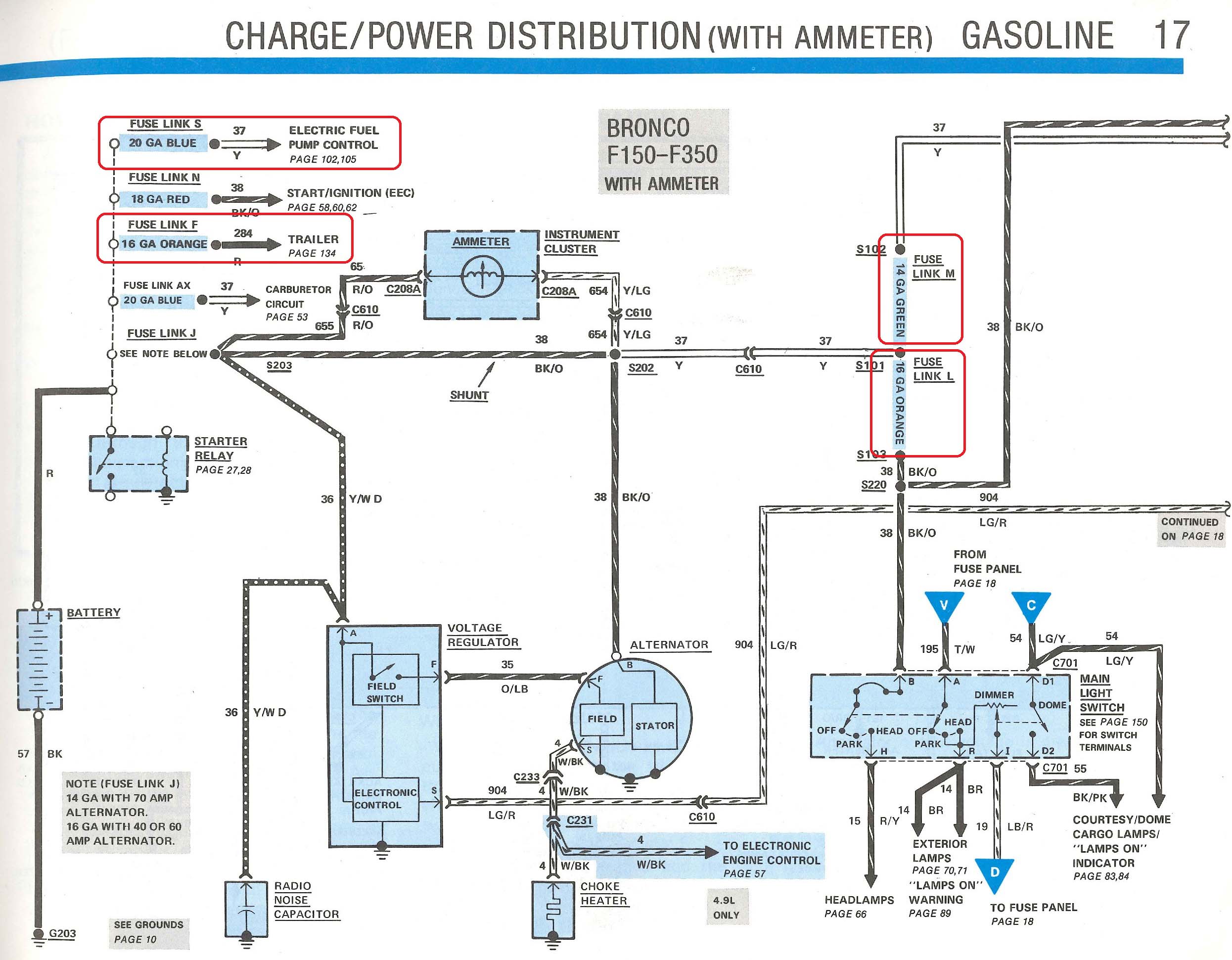 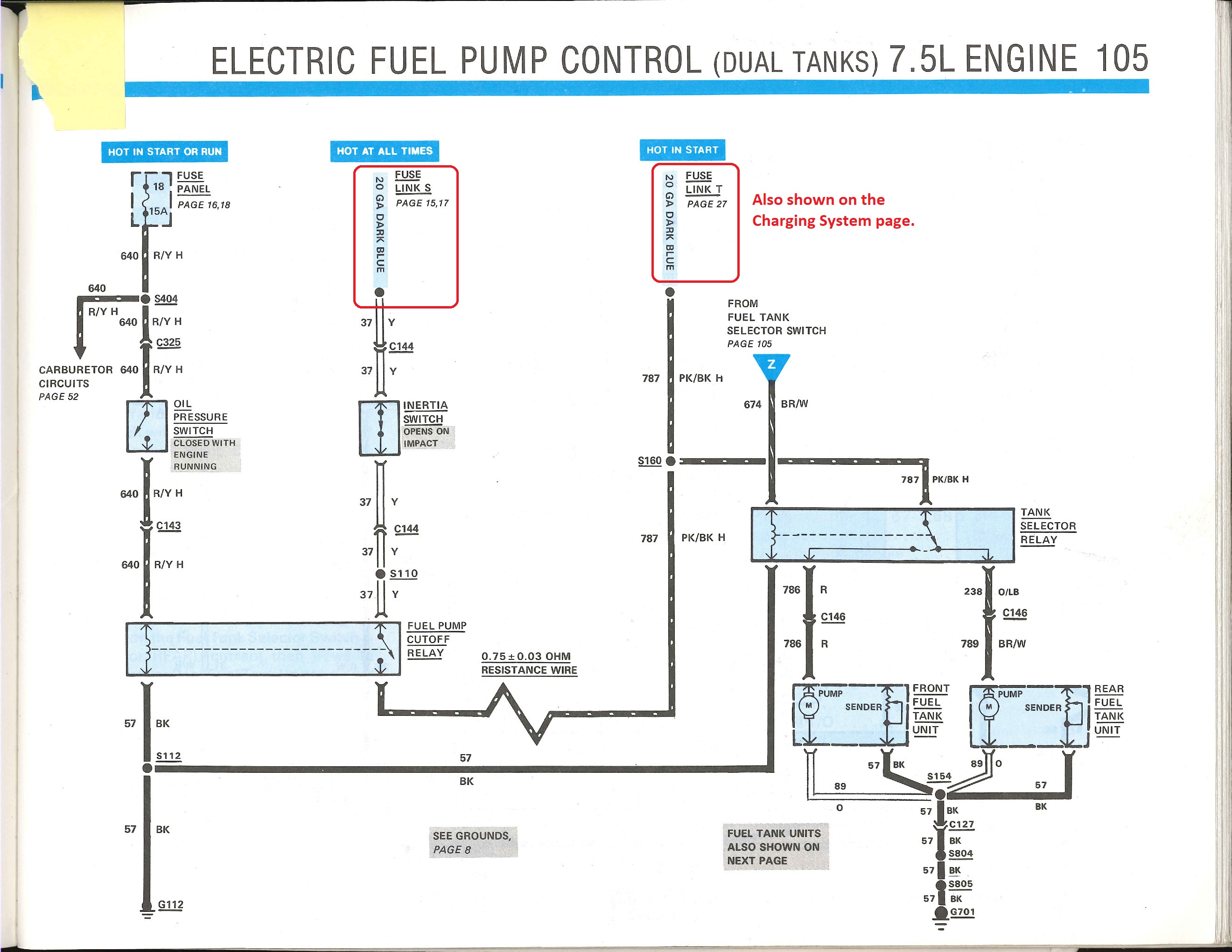
Gary, AKA "Gary fellow": Profile
Dad's: '81 F150 Ranger XLT 4x4: Down for restomod: Full-roller "stroked 351M" w/Trick Flow heads & intake, EEC-V SEFI/E4OD/3.50 gears w/Kevlar clutches
|
|
Administrator
|
A fuse link is meant to protect the harness and prevent a fire.
But it will take surge loads far beyond what a fuse will. I believe Bussmann & Littelfuse produce ultra slow blow fuses meant to replace them, and equivalence ratings are shown. You don't trust the experts that make Billions of fuses?
Jim,
Lil'Red is a '87 F250 HD, 4.10's, 1356 4x4, Zf-5, 3G, PMGR, Saginaw PS, desmogged with a Holley 80508 and Performer intake. Too much other stuff to mention. |
|
I've done some reading on this, but it gets deep fast. I don't have the engineering knowledge to answer.
From what I have read, it isn't a good idea. Fuse links act as a slow blow fuse, and the wiring in our old trucks is heavier than a more modern car, so the instant failure of a standard fuse isn't needed to protect the wiring. I've decided that no more often than fuse links fail, I'm leaving my trucks as they were built and leaving the fuse links in place. The only one that I've changed as an upgrade is the one that protects the charge circuit. I changed from a 16 gauge to a 14 gauge fuse link when I did my 3G conversion.
Ford Parts Monkey since 1985
1981 F100 Flareside - Black, 302-4V Roller/AOD 1986 F150 Flareside - Medium Fire Red 302/AOD 1989 F150 Standard Cab 4x4 - Dk Shadow Blue 302/AOD 1993 F350 4x4 Crew Cab - 7.3 IDI/ZF-5 I think it's a sickness... |
|
Administrator
|
So, a 10G wire then?
My understanding is that fuselinks are sized 4 gauges smaller than the circuit they protect. SAE J156 is VERY deep, indeed
Jim,
Lil'Red is a '87 F250 HD, 4.10's, 1356 4x4, Zf-5, 3G, PMGR, Saginaw PS, desmogged with a Holley 80508 and Performer intake. Too much other stuff to mention. |
|
In reply to this post by ArdWrknTrk
This^ they make fuse links that look like fuse blocks instead of wires.
1985 F-350 XL | 460 | C6 | "Rufus Maximus"
1986 F-150|Standard Cab|4x2|300Six|C6Transmission w/3.08 rear|Name:TBD 2021 Ranger XLT Super Crew | Cactus Grey | black out package | max tow |
|
Administrator
|
Try this information and see if it helps:
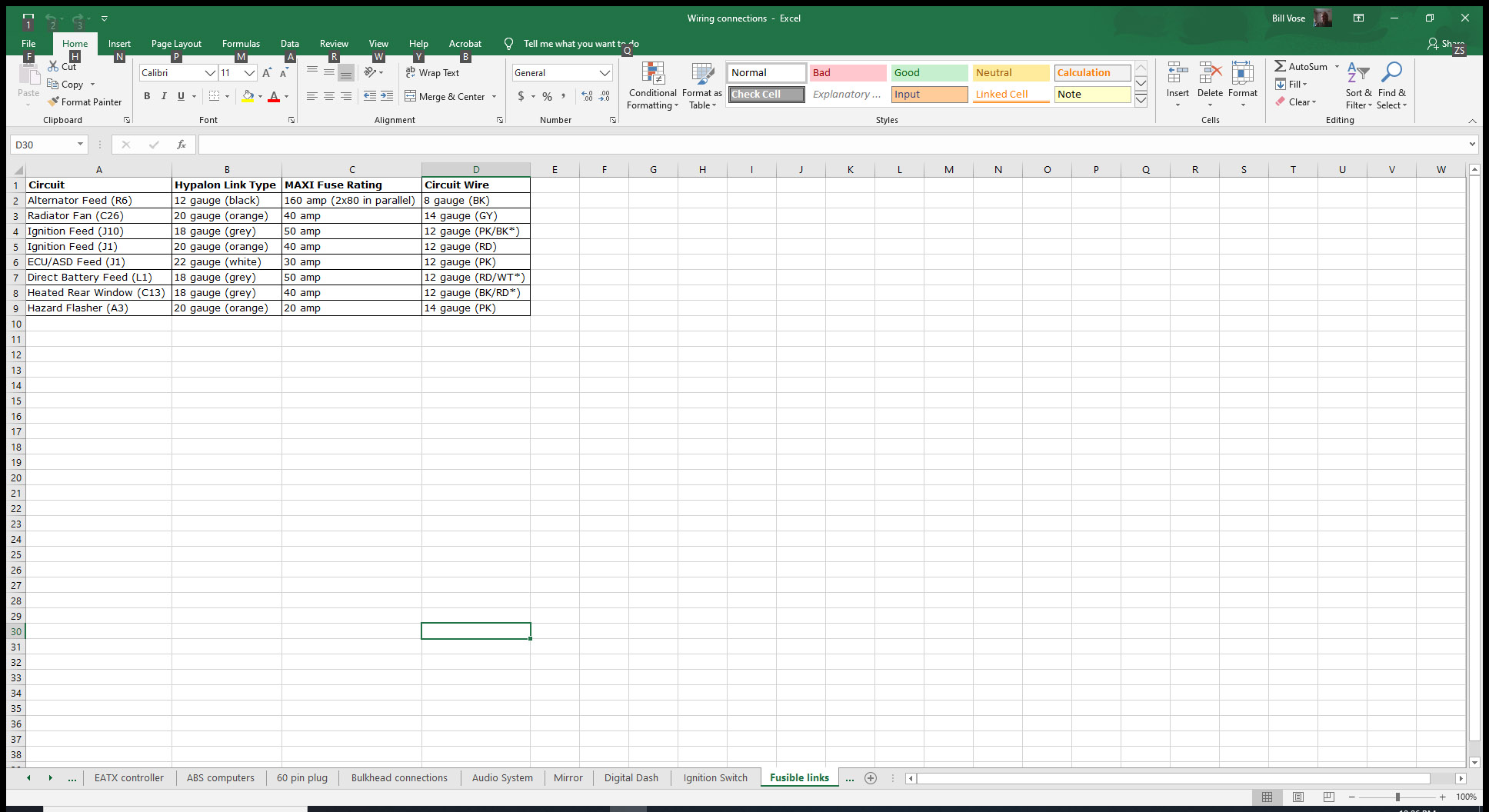 These are from a Chrysler site hence the odd circuit numbers. I also realize some of them don't jive.
Bill AKA "LOBO" Profile
"Getting old is inevitable, growing up is optional" Darth Vader 1986 F350 460 converted to MAF/SEFI, E4OD 12X3 1/2 rear brakes, traction loc 3:55 gear, 160 amp 3G alternator Wife's 2011 Flex Limited Daily Driver 2009 Flex Limited with factory tow package Project car 1986 Chrysler LeBaron convertible 2.2L Turbo II, modified A413 |
|
Administrator
|
In reply to this post by myrl883
Same here. In the middle of doing a lot of electrical upgrades but I've never had any real fuse link issues and don't really see a problem with them so am leaving them in place both at the fender solenoid and at the junction block (now aux batt solenoid). A small portion of that decision is that if I cut the fuse link out I would have to splice a short piece of wire to reach my fuse block and I am avoiding inline splices where possible.
Scott
'Camano' 1986 F250 Supercab XLT Lariat 460/C6 'Chanute' 1980 F350 C&C 400/NP 435 - Gin Pole But there ain't nothin' wrong with the radio |
|
Administrator
|
Ok guys, thanks for the input. You've given me a lot to think about.
Jim - You said "I believe Bussmann & Littelfuse produce ultra slow blow fuses meant to replace them, and equivalence ratings are shown." I'll go looking for that info. Did we talk about it recently? Bill - Your Chizzler info is helpful. Summarizing: 20 gauge is 20 to 40 amps18 gauge is 40 to 50 amps16 gauge was omitted but 60 to 80 amps14 gauge was omitted but might be 100 to 120 amps12 gauge is 160 ampsScott - I will have to splice short pieces of wire in as well, but am ok with doing that. I have another harness from which I can get the same wire so the sizes and colors will be consistent. But, at this point I'm not addressing any fuselinks at the aux battery solenoid. All - I understand that fuselinks don't fail very often. But having gotten down to fuselinks L & M, which are buried pretty deeply in the harness, I'd sure hate to have to replace them while on a trip. (I'll post pics in a bit of where they are.) And, as shown in the schematic below, I'd really like to replace the stuff in the orange rectangle below - Fuselink J and the shunt. But if Fuselink J is replaced by a fuse then it needs to support both fuselinks L & M. So why not replace them instead and not have anything for Fuselink J? 
Gary, AKA "Gary fellow": Profile
Dad's: '81 F150 Ranger XLT 4x4: Down for restomod: Full-roller "stroked 351M" w/Trick Flow heads & intake, EEC-V SEFI/E4OD/3.50 gears w/Kevlar clutches
|
|
Administrator
|
This post was updated on .
So you are talking about cutting at splices 102 and 103 and hooking them up directly in your fuse box?
With going to the 1 wire alt I heavily simplified the left hand portion of C610 and I did connect the Y (cab power) to a 60 amp fuse in my fuse block. I didn't modify those fuse links though. Edit: post corrected/updated - I was incorrectly reading L and M as being under the dash - which did sound odd. What does T/O stand for in the location chart?
Scott
'Camano' 1986 F250 Supercab XLT Lariat 460/C6 'Chanute' 1980 F350 C&C 400/NP 435 - Gin Pole But there ain't nothin' wrong with the radio |
|
Administrator
|
I'd say splices 102 & 103 are where I'm connecting and extending to the PDB. And, as you've figured out, they aren't under the dash. In Big Blue's case they are on the passenger's fender liner, and I'll show a pic in a bit when I get back from a meeting at church.
But you kept L & M and replaced J w/a 60 amp?
Gary, AKA "Gary fellow": Profile
Dad's: '81 F150 Ranger XLT 4x4: Down for restomod: Full-roller "stroked 351M" w/Trick Flow heads & intake, EEC-V SEFI/E4OD/3.50 gears w/Kevlar clutches
|
|
Administrator
|
It was the 'Near Fuel Tank Selector Switch T/O' that was throwing me off with those splice locations.
Correct. Granted, I had put together this change as my first foray into making wiring changes on the truck so I am interested in all of your findings and if I need to change anything. My post on this change is here and this is where the 60 was recommended: https://www.ford-trucks.com/forums/1570236-1-wire-alternator-and-voltmeter-rewire-diagram.html I hadn't really thought about it since then though so glad you started this thread. I am not sure the 60 is correct and now with the blower relay mod, it may be way off.
Scott
'Camano' 1986 F250 Supercab XLT Lariat 460/C6 'Chanute' 1980 F350 C&C 400/NP 435 - Gin Pole But there ain't nothin' wrong with the radio |
|
Administrator
|
In reply to this post by Gary Lewis
Gary, on Fords, so far I haven't had one fail, Matt did on his 1986, the one from the alternator, which promptly took out the 2G alternator. Chrysler, had more than a few fail, and on the FWD models all except the hazard flasher are clustered if a fan shape near the bulkhead connector and are a royal PITA to fix, hence the nice PDC in the konvertible.
Bill AKA "LOBO" Profile
"Getting old is inevitable, growing up is optional" Darth Vader 1986 F350 460 converted to MAF/SEFI, E4OD 12X3 1/2 rear brakes, traction loc 3:55 gear, 160 amp 3G alternator Wife's 2011 Flex Limited Daily Driver 2009 Flex Limited with factory tow package Project car 1986 Chrysler LeBaron convertible 2.2L Turbo II, modified A413 |
|
Administrator
|
Bill - I haven't had one fail either, but I've helped quite a few people on various forums or on Facebook that have had problems with fuse links. Maybe because they did something dumb, but it does worry me.
As for where these things are, here's a pic of where all these things are. You can see that fuse links L & M are way down on the fender apron and would be difficult to change while on the road as you have to get to S102 and S103. And don't forget that all of this is normally covered with many turns of electrical tape. It probably took me over 15 minutes to get this much stripped back. 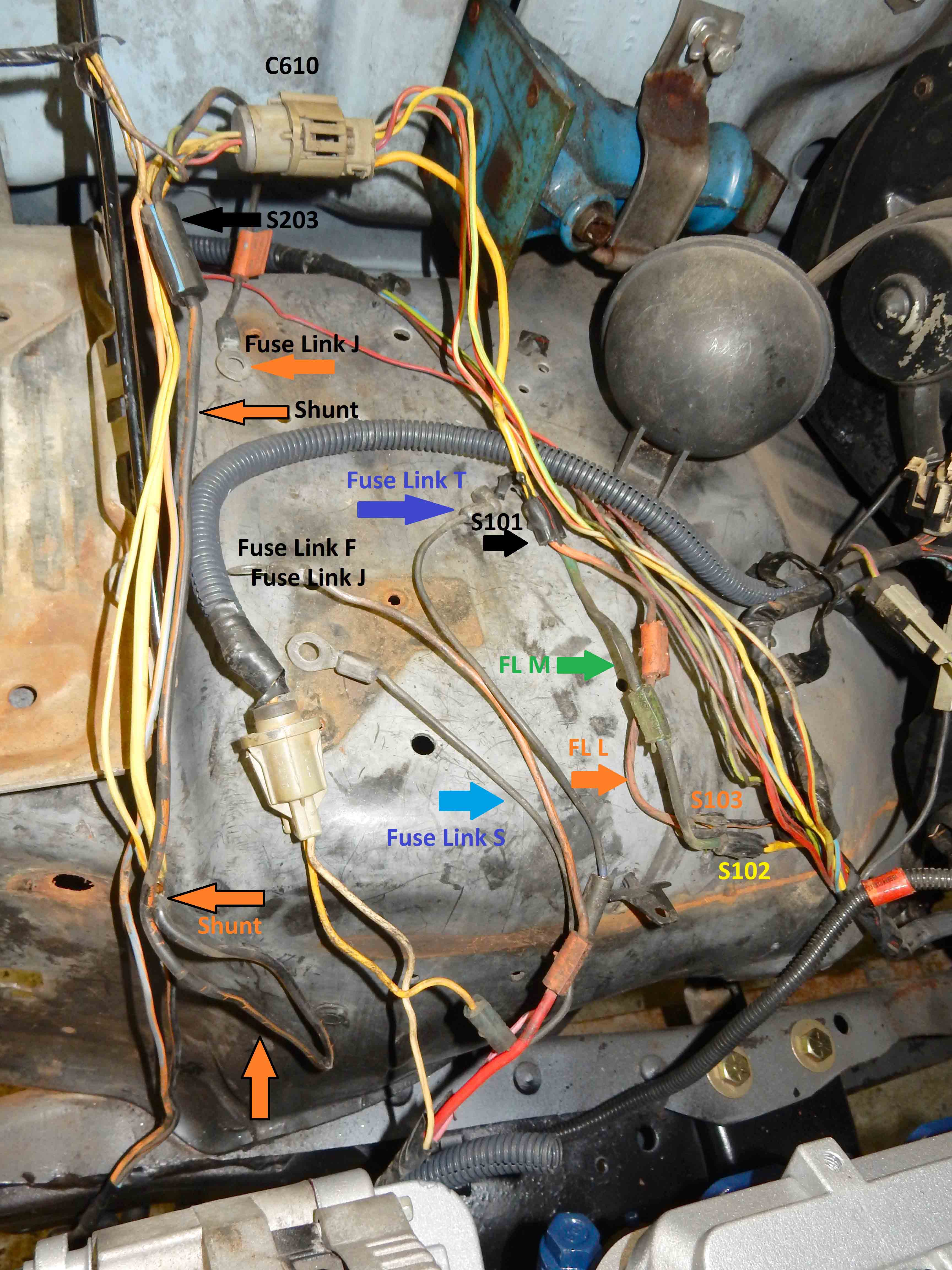
Gary, AKA "Gary fellow": Profile
Dad's: '81 F150 Ranger XLT 4x4: Down for restomod: Full-roller "stroked 351M" w/Trick Flow heads & intake, EEC-V SEFI/E4OD/3.50 gears w/Kevlar clutches
|
|
Administrator
|
In reply to this post by Gary Lewis
Did some very quick looking and seems like 60amps is a pretty common consensus for a 16ga fuse link replacement so I feel safe leaving it as is. As has been mentioned in this thread also, most of those threads have a comment somewhere about there not being a straight conversion.
Since as you [Gary] said the fuse ratings add up well beyond 60 in this case so I don't know if one could even drop the fuse (that replaces the fuse link) amps down if they eliminate a few of the heavy draws. But... Fuse Link L - the headlight relays reduce a significant portion of the load Fuse Link M - the blower relay reduces a significant portion of the load. Additionally, are you keeping the aux battery connected through this circuit? I ask because if you are use the smart isolator with the boost functionality, you will be running a larger cable and can eliminate this aux battery load as well as the trailer lamps/brakes from this circuit. For instance I have a fused 1/0 running from the main battery to the smart solenoid and then a fused 1/0 from the smart solenoid to the aux battery and am leaving the Yellow wire disconnected from the solenoid (used to be the junction block) at C232. That way the 1/0 handles both the aux battery and those trailer circuits.
Scott
'Camano' 1986 F250 Supercab XLT Lariat 460/C6 'Chanute' 1980 F350 C&C 400/NP 435 - Gin Pole But there ain't nothin' wrong with the radio |
|
Administrator
|
I had planned to use Fuse Link M and the big yellow wire to continue to serve the aux battery. The reasoning there is that the EFI wiring has a very large wire running from the battery/my PDB to the EFI PDB on the driver's side. So I don't want to run a new wire just to replace it when I do the EFI.
But you are correct that the headlight relays and the blower motor relay will take fuse links L and M, respectively.
Gary, AKA "Gary fellow": Profile
Dad's: '81 F150 Ranger XLT 4x4: Down for restomod: Full-roller "stroked 351M" w/Trick Flow heads & intake, EEC-V SEFI/E4OD/3.50 gears w/Kevlar clutches
|
|
A few interesting reads on fuse links.
http://www.starquestclub.com/forum/index.php?showtopic=107395 https://www.whiteproducts.com/fusible-faqs.shtml https://www.wiringdepot.com/jt-t-tech-articles/Fusible-Link-Wire-FAQs This statement here is somewhat right but just using what standard wire size is rated to carry in amps. 18 gauge fusable links are rated at 14 gauge wire or 15 amps , 16 gauge are rated at 12 gauge wire or 20 amps. The fusible link that protects the wire should then be two gauge sizes (or four numbers larger). Looks like most I have read agree on they are not rated like fuses but more so engineered for what they are protecting. What are the ratings for fusible links? Fusible links are not rated in amps like fuses because each installation is unique and designed to meet specific circuit protection requirements.
Eddie,
81 F100 Custom SWB, 5.0L, 4x2, Single Rail Four-Speed Overdrive, 3.00 Non-Limited Slip Rear Axle, Non A/C truck to complete 85 F150 factory A/C conversion, Nutmeg interior color. |
|
Administrator
|
In reply to this post by Gary Lewis
81f100custom - I see you've replied while I've been working on my post, so I'll reply to yours in a bit.
Ok, I've done some measuring. And I've included a chart from Offroaders that Jonathan pointed out. Plus, Scatch pointed out the calculator at WireBarn. I've used both of these on the observations below. However, the table doesn't say what voltage drop it is allowing, but I've been able to determine that it is apparently using a 3% drop for the conservative #'s and a 5% drop for the others by comparing it to the WireBarn calculator. Which voltage drop is "right" for our trucks? I don't know, but I think it varies by the device you are powering. For instance, lighting doesn't like much voltage drop or you lose a lot of light. On the other hand, the radio doesn't care too much, although you may have to turn the volume up slightly to accommodate a lower voltage. Also, I've found that the wire that Ford used is ~.135" in diameter for a 12 gauge conductor, and ~.175" for a 10 gauge conductor. And I'll probably have to fill that in for other gauges as we go on with this..... So here are two of the wire sizes and current capacities: Ckt 37: The yellow wire that goes from S102 is a 10 gauge and the run is 7' long to S208 that feeds both the ignition switch and the fuse block. (It is another 1' on to the switch and the fuse block, but they are fed by their own wires so that doesn't count.) The table below suggests that #10 can support right at 65 amps, but that would be pushing it. But the WireBarn calculator says that at a 5% voltage drop #10 can support 90 amps up to 7.68'. However, if you hold the loss to 2% you can only carry 40 amps for 6.91'.Ckt 38: The black/orange wire that goes from S103 to the headlight switch is a 12 gauge and the run is 8'. The table says 20 amps is about right for it, and WireBarn agrees that you can run 20 amps out to 8.69' with a 2% loss. On the other hand, WireBarn says #12 is good for 50 amps out to 8.69' with a 5% drop.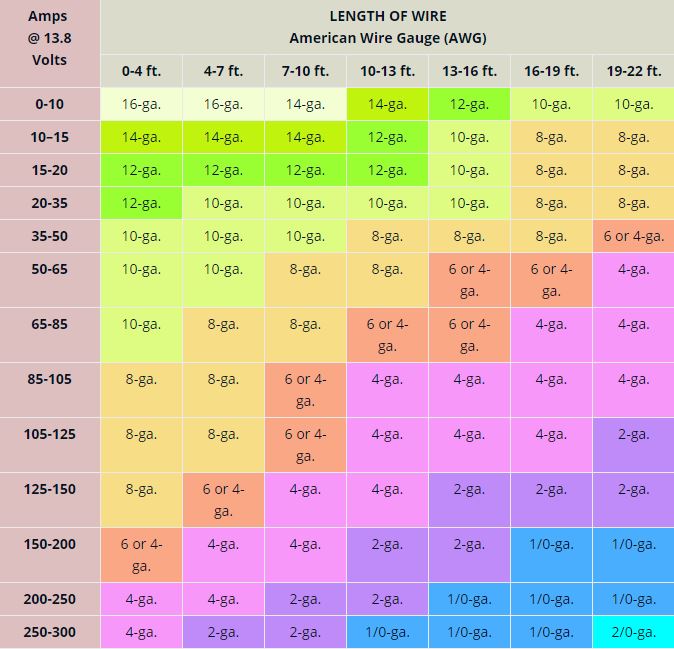 Meanwhile, back at the ranch, I've researched the slow-blow fuse idea. And I haven't found any - yet. I did find this page on the Littelfuse site that says "The MAXI® fuse uses “Diffusion Pill Technology” to provide predictable time delay characteristics and low heat dissipation." And then provides the chart below. So, I called Littelfuse. The first person I talked with didn't think they have slow-blow fuses in the Maxi size, but said he'd get a technician to email with me on it. So far there's been no response. 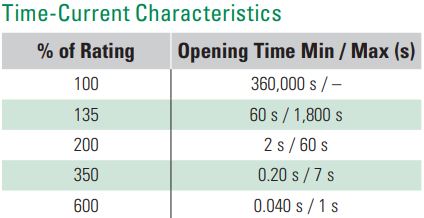 Now I'll go read 81f100custom's post and reply.... 
Gary, AKA "Gary fellow": Profile
Dad's: '81 F150 Ranger XLT 4x4: Down for restomod: Full-roller "stroked 351M" w/Trick Flow heads & intake, EEC-V SEFI/E4OD/3.50 gears w/Kevlar clutches
|
|
Administrator
|
In reply to this post by 81f100custom
Ok, 81f100custom, I've read all the links.
The Starquest guys appears to be just like us, another group of guys that are struggling through this but don't have any specific technical credits to their names. But White Products and Wire Barn are not just guys like us - they are manufacturers and/or vendors. However, their pages are identically worded, so it suggests that they may have gotten the wording from elsewhere. Maybe an official site? In any event, it does carry some weight. And while fuse links aren't specifically rated, like fuses, there has to be a current rating range for each size. And the automotive engineers then select the fuse link to fit the current the devices on that wire will pull. That's the "engineering" they do. However, some of us are "re-engineering" these trucks. For instance, Fuse Link L was sized to support the headlights as well as the other lighting. But I'm moving that current off to fused relays, and that's probably about half of the current on that circuit. Similarly, I'm going to power the HVAC blower's high speed, where it pulls the most current, via a fused relay. And since the A/C-Heater circuit is fused at 30 amps, a bunch of amps are going to be pulled off of Fuse Link M. So, I'm playing "engineer" in this case. But, I'd like to do it correctly, and appreciate your input. It has given me more to think about. 
Gary, AKA "Gary fellow": Profile
Dad's: '81 F150 Ranger XLT 4x4: Down for restomod: Full-roller "stroked 351M" w/Trick Flow heads & intake, EEC-V SEFI/E4OD/3.50 gears w/Kevlar clutches
|
| Edit this page |

